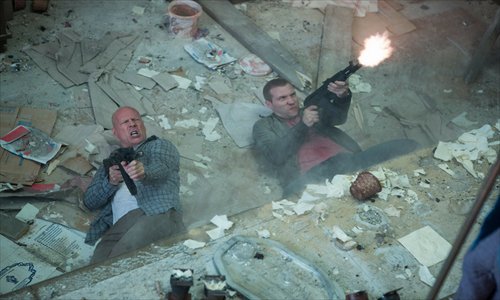High hopes Die Hard

For audiences who find themselves increasingly bogged down with Beijing's homegrown hazards, from overwhelming traffic and dense pollution to countless episodes of corrupt officialdom, A Good Day to Die Hard, directed by John Moore, could well be what's needed to take the edge off.
A Good Day to Die Hard, the fifth film of the Die Hard series, was released in Beijing cinemas on March 14. In it, Bruce Willis as John McClane teams up for the first time with his own flesh and blood, Jack McClane (Jai Courtney), a CIA officer working undercover. When Jack is held prisoner in Moscow, both he and fellow prisoner Yuri Komarov (Sebastian Koch) are presented before the Russian courts to testify against corrupt official Viktor Chagarin (Sergei Kolesnikov), who withholds from them a fair trial. McClane soon hears the news and leaves New York in search of Jack, whom he has not seen or spoken to in three years.
Road rage features heavily in A Good Day to Die Hard and is a fairly familiar concept to anyone who has ever ventured further than their front door in Beijing. Scenes in the film set in Moscow also show roads bearing remarkable similarity to those in Beijing. Take away the Russian architecture, and you're pretty much looking at rush hour in Chaoyang's CBD on any given weekday.
McClane's attempt to rescue his son in Moscow leads to a series of car chases. Unfortunately, Moore's direction of the sequence consists more or less in rattling the camera from left to right in each shot before the audience has time to question his technique.
Nevertheless, the chase does reflect the beliefs of so many privileged motorists in Beijing, which is that size necessarily enhances right-of-way. In a race against time to catch up to Jack, McClane crashes through the balustrade of a highway bridge behind the wheel of a high-jacked Land Rover. Mounting the line of traffic directly below, he manages to pursue the chase with relative ease, flattening cars one after the other. Who in Beijing that owns a 4x4 wouldn't get excited by this after the umpteenth afternoon facing gridlock?
The cab drivers in Die Hard's post-Soviet Russia are different from Beijing cabbies however. McClane's brief exchange with a Russian cabby involves the driver delivering a heartfelt rendition of Frank Sinatra's "New York, New York." "Everyday is like this," the driver breaks off to complain, gesturing at the traffic jam. McClane opts to walk instead, giving the cab driver his fare. "No need," the cabby says cheerfully. "You listened to me sing for chrissake! I insist, no need." Needless to say, cabbies in Moscow on wages similarly low to Beijing cab drivers probably aren't as carefree in reality.
Portrayals of the US and Russia in A Good Day to Die Hard nonetheless constantly lean toward extremes. Comparisons with Beijing aside, the viewer cannot help but roll their eyes at the film's jingoistic cinematography. Scenes of America are exclusively shot in daylight in the film; Russia in harsh, dark climates.
The film culminates in a face-off involving McClane, Jack and Komarov in Chernobyl, Ukraine. McClane and Jack, at first estranged, eventually see eye to eye, their father-son relationship renewed in the course of an hour.
McClane's relationship with Jack however fails to convince. This is a pity, since arguably one of the most memorable films of the series, Die Hard with a Vengeance (1995), is exciting precisely because of the comic tension between Willis and co-star Samuel L. Jackson.
A Good Day to Die Hard may well present a vision of Russia that makes bugbears in Beijing seem more forgiving. Believing in that world, however, requires more than the usual suspension of disbelief.